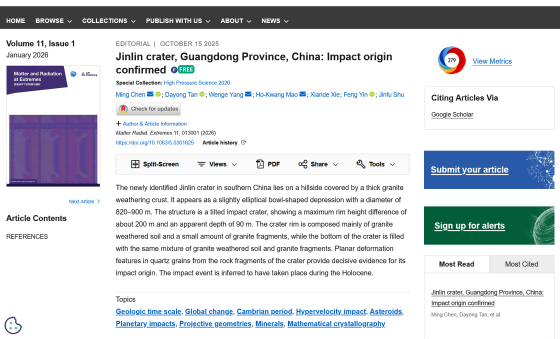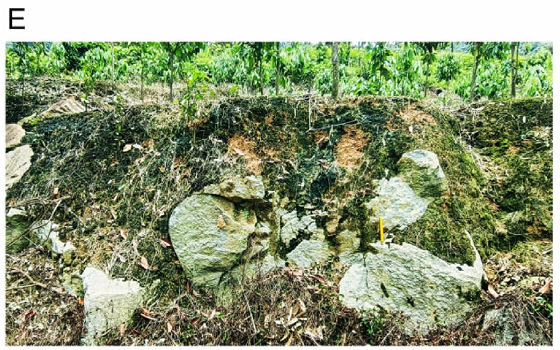Extraordinarily large crater measuring approximately 900m in diameter discovered in southern China

A huge crater measuring 820-900 meters in diameter has been discovered in
Jinlin crater, Guangdong Province, China: Impact origin confirmed | Matter and Radiation at Extremes | AIP Publishing
https://pubs.aip.org/aip/mre/article/11/1/013001/3367917/Jinlin-crater-Guangdong-Province-China-Impact

Earth's largest modern crater discovered in Southern China
https://phys.org/news/2025-11-earth-largest-modern-crater-southern.html
China's 900 Meter Impact Crater Rewrites Recent History - Universe Today
https://www.universetoday.com/articles/chinas-900-metre-impact-crater-rewrites-recent-history
The newly discovered Jinlin Crater is an oval-shaped crater with a diameter of 820-900m and a depth of approximately 90m, formed on the slope of a hill covered with a thick weathered crust of granite . Because Jinlin Crater is hidden in the hilly area, it was not identified as a crater for a long time.
The large depression in the center of the photo is the Jinlin Crater, discovered in Zhaoqing City. Although the surface is covered with trees and grass, the shape of the crater remains clearly visible.

There are only about 200 confirmed impact craters on Earth, and the Jinlin crater stands out for its size and age.
The Jinlin Crater is thought to have formed in the early or middle
Until now, the largest crater in the Holocene was the Macha crater in Russia, which was approximately 300 meters in diameter, but the Jinlin crater is significantly larger.
Astronomy media University Today explains, 'The discovery of such a large and well-preserved crater is surprising given the region's climate. Guangdong is hit by regular monsoons , heavy rains, and high humidity—conditions that accelerate erosion, so any visible crater would have disappeared long ago. However, a thick layer of weathered granite protected the structure from the wind, leaving the Jinlin crater remarkably intact.'
The photo below shows a cross section of the slope at the crater rim, revealing red weathered granite and sedimentary structures containing granite fragments.

The photo below shows a geological cross section taken at the bottom of the crater. Weathered granite and granite fragments are mixed together to form a sedimentary structure.

The research team discovered unique microstructures called planar deformation features (PDFs) in quartz fragments found in the granite layer of the Jinlin Crater. Quartz with planar deformation features is called impact quartz , and on Earth it is only formed by powerful shock waves from impacts such as meteorites.
'This discovery indicates that the scale of small body impacts on Earth during the Holocene is much larger than previously recorded,' said Ming Chen, lead author of the paper.
Related Posts:
in Free Member, Science, Posted by log1h_ik







